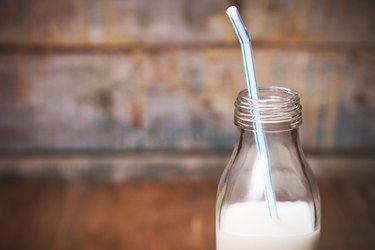
Milk has many vital health benefits for both children and adults. Among its nine essential nutrients, milk provides calcium and vitamin D for strong bones and teeth, protein for energy and muscle repair, vitamin B12 for healthy red blood cells and nerve tissue and niacin for effective metabolism. You may have your preference for whole vs. nonfat milk, but your body digests both varieties in nearly the same manner.
Carbohydrate Digestion
Video of the Day
All milk varieties contain the carbohydrate lactose, or milk sugar. Lactose is a disaccharide composed of one unit each of the sugars galactose and glucose. Since the human body cannot digest disaccharides, it must first break down lactose into its subunits using the enzyme lactase. This occurs in the small intestine. The body then absorbs the galactose and glucose subunits directly into the bloodstream through the intestinal walls. Both whole and nonfat milk contain about 12 g of sugar per 8 oz. serving, according to the USDA National Nutrient Database.
Video of the Day
Protein Digestion
Digestion of milk protein begins in the stomach. Most proteins are too large to digest as is. Stomach acid begins the process by denaturing proteins to allow for easier digestion. Denatured proteins then enter the small intestine where protein enzymes, from pancreatic juice, break down proteins into smaller peptide chains or free amino acids. These smaller forms are then absorbed through the small intestine into the bloodstream. Whole and nonfat milk each contain 8 g of protein per 8 oz. serving.
Lipid Digestion
Amount of milk fat is the only real difference between nonfat and whole milk, and your body digests the two types of milk slightly differently because of it. When you consume fat, your body sends a signal to the gallbladder to release bile. Bile enters the small intestine, where it then breaks down large fat molecules into smaller fatty acids. Free fatty acids then enter the lymphatic system through the small intestine, where they re-form into large fat molecules. These molecules then travel through lymph and enter the bloodstream through the veins of the chest. While nonfat milk does not have fat, it does contain another lipid, cholesterol. Cholesterol digestion is similar to fat digestion. Whole milk has about 8 g of fat and 24 mg of cholesterol per 8 oz. serving; nonfat milk contains only 5 mg of cholesterol.
Complications
Certain conditions can complicate milk digestion, regardless of the variety. If you have lactose intolerance, your body does not produce enough lactase enzymes to break down lactose efficiently. This forces the body to ferment lactose instead, resulting in uncomfortable bloating, gas, nausea and diarrhea. Another complication, milk allergy, is often confused with lactose intolerance, according to the Mayo Clinic. Milk allergy is an immune reaction to milk protein, causing hives, wheezing, diarrhea, abdominal cramps and rashes. Serious reactions can induce anaphylaxis, which constricts the airways and makes breathing difficult.
- Oprah.com; The Health Benefits of Milk; Lisa Capretto; March 2010
- Elmhurst College Virtual Chembook; Lactose; Charles E. Ophardt; 2003
- National Digestive Diseases Information Clearinghouse; Your Digestive System and How It Works; April 2008
- USDA Nutrient Data Laboratory; National Nutrient Database for Standard Reference
- National Digestive Diseases Information Clearinghouse; Lactose Intolerance; June 2009